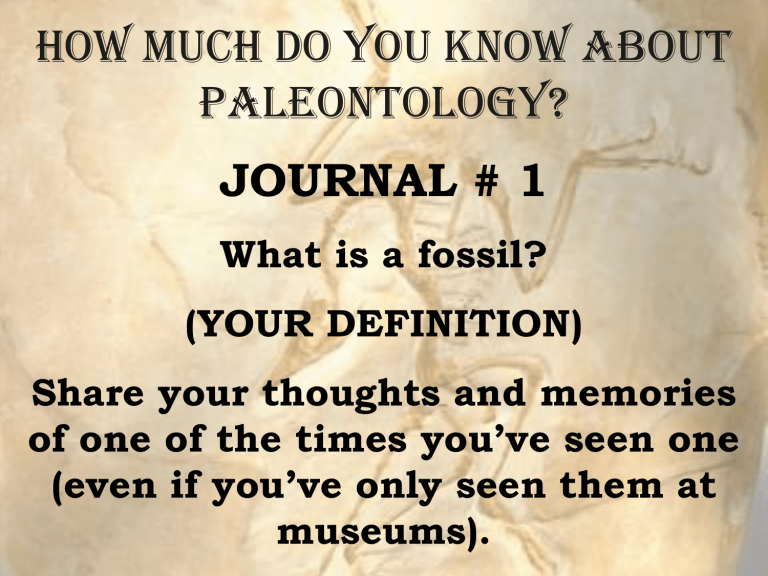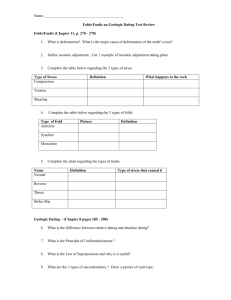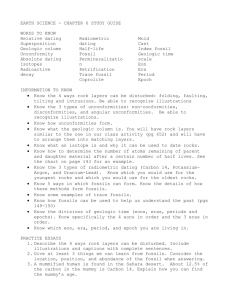Paleontology Notes

How much do you know about
Paleontology?
JOURNAL # 1
What is a fossil?
(YOUR DEFINITION)
Share your thoughts and memories of one of the times you’ve seen one
(even if you’ve only seen them at museums).
How much do you know about
Paleontology?
Pre-Unit Questions
Answer the following
True/False Questions
A. True
B. False
We can use carbon dating to identify the age of a dinosaur fossil.
How much do you know about
Paleontology?
FALSE.
Although carbon dating is used to date formerly living organisms, dinosaurs are considered far too old to date using carbon14’s shorter half-life.
Many scientists
A. True
B. False theorize that dinosaurs were wiped out many years ago by some great catastrophe.
How much do you know about
Paleontology?
TRUE.
Obviously dinosaurs don’t exist today and they seem to disappear suddenly from the fossil record.
A. True
B. False
Fossils take millions of years to form.
How much do you know about
Paleontology?
TRUE or FALSE?
FALSE.
Fossils can form in less than a year depending on the conditions.
A. True
B. False
Through radiometri c dating, we can identify the age of
A dinosaur fossil.
How much do you know about
Paleontology?
FALSE.
At least NOT DIRECTLY -
Radiometric dating (except carbon dating) is mostly performed on igneous rocks. Fossils form in sedimentary rock.
A. True
B. False
There are billions of fossils found all over the earth.
How much do you know about
Paleontology?
TRUE.
There are many fossils buried in the rock all over the planet. Over 99% of them are small marine plants and animals.
A. True
B. False
Dinosaurs are “giant lizards.”
How much do you know about
Paleontology?
FALSE.
Some were large, but many were not. The term dinosaur, coined in the 1800’s, does mean
“terrible lizard,” but the average size of a dinosaur was that of a large dog.
History of
Paleontology in the
USA
Geology:
Paleontology
& Geologic
Time
Created in 2008 by Tim F. Rowbotham
Geology
is the study of the origin, history, and structure of the earth.
Paleontology
is the study of prehistoric life, particularly through fossil remains.
Fossils
are the remains , imprints , or traces of prehistoric organisms.
Fossil Formation
Requires shelter from scavengers , decay , and physical destruction .
Fossil Formation
• Most commonly occurs through quick burial by sediment .
• Is more likely to occur with hard parts such as bone , shells , and teeth .
How fossils form
VIDEOS
• How Fossils Form 1
• How Fossils Form 2
• Prospecting for Dino
Fossils
Types of
Fossils
Types of Fossils
• Permineralized remains
• Carbon films
• Molds & Casts
• Original Remains
• Trace Fossils
Permineralized Remains
occur when parts of the original remains are replaced by minerals flowing through ground water.
This process is called petrification .
Carbon Films
occur when pressure from layers of sediment leaves only a thin carbon residue .
Molds & Casts
Formation of fossil shell molds
Molds
are hollow areas left in sediment that show the shape of the original organism.
Casts
are copies of the shape of original organism that form from minerals deposited into the mold .
Molds & Casts
Formation of fossil shell molds
Original Remains
including the soft parts of the organism are sometimes found in hardened tree resin , frozen ground , or tar pits .
Original Remains
Dino Mummy
Trace Fossils
provide evidence of an organism’s activity . They include footprints , trails , burrows , and excrement .
PALEONTOLOGY
Dinosaur Fossils PICTURES
How are fossils discovered & collected?
Journal #2
List 3 types of fossils and give a brief description of each.
READY YOUR REMOTES
Types of Fossils
• Permineralized remains
• Carbon films
• Molds & Casts
• Original Remains
• Trace Fossils
Sue, the T-Rex
Waking the T-Rex
Some interesting Sue facts...
It took six fossil hunters 17 days to get Sue out of the ground but 10 museum preparators two years(30,000 hours of preparation time) to clean and repair the bones.
A T. rex skeleton is made up of approximately 321 bones. Sue was found with most of these but was missing most of one foot, one arm, a few ribs and vertebrae, and some other small bones.
FOSSSIL COLORS
• Yellow
• Pink
• Light Blue
• Turquoise
•Mint Green
•White
•Purple
•Salmon
Dinosaur National Monument
Dinosaur National Monument
Dinosaur National Monument
•Yellow
•Orange
•Pink
•Light Blue
•Turquoise / Grey
•Mint Green
•White
•Purple
•Salmon
Fossil Identification
Simulation
Acquire a Fossil
Identification Simulation
Worksheet.
Fossils
Where Fossils are Kept VIDEO
Paleontology
Digging Up a Dinosaur Graveyard
T-Rex Blood VIDEO
Relative Age
is the age of a rock or fossil compared to the ages of other rocks or fossils .
Catastrophism
is the belief that the earth’s geological features were formed rapidly as a result of large catastrophes.
Catastrophes
that could cause rapid geologic change include landslides , volcanic eruptions , floods , and earthquakes .
Uniformitarianism
is the idea that the processes occurring on earth today are similar to those that occurred in the past.
Uniformitarianism
basically says
“The present is the key to the past .”
Uniformitarianism
is the idea that geological features formed slowly over long periods of time.
Catastrophism vs.
Uniformitarianism
Uniformitarianism Catastrophism
Geologic
Features
Age of the earth
Form slowly over time
Form rapidly due to major forces & events
Billions of years
Thousands of years
Paleontology
Notes
Catastrophism
OR
Uniformitarianism
Catastrophism & a
Young Earth
Where would dinosaurs fit in?
DRAGONS or DINOSAURS VIDEO
(FULL VIDEO 1:24)
Watch from 3:09 – 15:44
Catastrophism & a
Young Earth
Where would dinosaurs fit in?
DRAGONS or DINOSAURS
NOTES
Videos
Fossil Evidence for Catastrophism
Catastrophism & Coal Deposits
LIVING DINOSAURS 1
LIVING DINOSAURS 2
Principle of Superposition as sedimentary rocks form, they are deposited on older rock layers.
Principle of Superposition in undisturbed layers, the oldest is on the bottom and higher layers are younger.
Principle of Superposition
Oldest layer is on bottom (1)
Badlands Style
Principle of Superposition
The Grand Canyon
Principle of Superposition
Younger Layers of Rock
Older Layers of Rock
The Grand Canyon
Extrusions
are igneous rocks layers that form on the surface when lava hardens.
Extrusions
are always younger than the layers over which they form.
Extrusions
Intrusions
are igneous rocks that form when magma pushes up into rock layers.
Intrusions
are always younger than the rock layers they invade.
Intrusions & Extrusions
Extrusion
Intrusion
Intrusions & Extrusions
Journal #3
Draw the following geologic cross-section:
1.) 2 layers of sedimentary rock form.
2.) An extrusion forms on top of the two layers.
3.) A 3 rd layer of sedimentary rock forms.
4.) An intrusion cuts through the all the rock layers, but not to the surface.
5.) A 4 th layer of sedimentary rock forms.
Paleontology
Notes
PAGE 6
Faults
are breaks in the earth’s crust. A fault is always younger than the rock it cuts through.
Faults
Folds
occur when rock layers are compressed together and bend or curve .
Journal #4
Draw the following geologic cross-section:
1.) 2 layers of sedimentary rock form.
2.) The 2 layers of rock are folded.
3.) A 3 rd sedimentary layer forms.
4.) A fault cuts through all the layers, shifting some rock up.
5.) A 4 th sedimentary layer forms.
6.) An intrusion cuts all the way to the surface forming an extrusion.
Unconformities
are gaps in the rock sequence
(caused by the erosion of rock layers).
Angular Unconformity occur when rock layers are tilted or uplifted , and then worn down by erosion and weathering .
Sediments are then deposited on top of these eroded layers.
Angular Unconformity
Angular Unconformity
Disconformities
are gaps created when erosion occurs on an overlying rock layer.
Disconformity
Disconformity
Nonconformity
are formed when sedimentary rock overlays igneous or metamorphic rocks.
Nonconformity
Unconformities
Relative Dating Example
SOME Relative
Dating Practice
Write the correct order of events by numbering their occurrences.
Include any and all cross-cut relationships.
Relative Dating
Relative Dating
Relative Dating
Correlation
is using rock and fossil evidence to match up dating at different locations .
Correlation
Index Fossils
are used for dating the rock layers in which they are found.
Index Fossils
are species that were abundant all over the earth, but existed for shorter periods of time.
Index Fossil
Correlation using index fossils
Index Fossil
Correlation using index fossils
Journal #5
Draw a geologic cross-section with the following:
1.) At least 5 sedimentary rock layers
2.) At least 3 cross-cuts
(faults, folds, intrusions, extrusions, or unconformities)
Number the events & write a brief geologic history that explains the order of occurrence of each event.
Absolute Age
is the age in years of a rock or other object (as determined by radiometric dating.
Radiometric Dating
entails finding the amount of certain radioactive elements left in a rock or object.
Radioactive Decay
is the release of particles and energy from the nuclei of unstable atoms.
Radioactive Elements
are elements whose nuclei are unable to hold together, and eject particles and energy.
The Parent Element
is the element whose nucleus radioactively decays into another element.
The Daughter Element
is the new element that is produced after the decay of the parent element.
Half-Life is the time it takes for half of the atoms in a sample to decay .
Half-Life is always the same . It does not depend on the amount of atoms.
Half-Life is unaffected by almost all other outside factors.
Decay occurs at a steady rate.
Sample Half-lives
ISOTOPE
HALF-LIFE
PARENT DAUGHTER
URANIUM 238 LEAD 206 4.5 BILLION YEARS
POTASSIUM 40 ARGON 40
THORIUM 232 LEAD 208
CARBON 14 NITROGEN 14
1.3 BILLION YEARS
14.0 BILLION YEARS
5,730 YEARS
Sample Half-lives
Iodine-129
Carbon-14
Strontium-90
Sodium-24
Technetium-99
Fluorine-18
Oxygen-15
16,000,000 years
5730 years
28 years
15 hours
6 hours
110 minutes
124 seconds
Radiometric Dating
As time passes, the amount of a parent isotope in a rock decreases as it decays.
It has decayed into the daughter element.
Radiometric Dating
basically involves measuring how much of the daughter element has formed.
Age Determination
can then be made by using the known half-life to determine how much time has passed.
Age Determination
typically, the dating can be estimated only up to a MAX of 10 half-lives.
Common Types of
Radiometric Dating
Potassium-argon dating
Uranium-lead dating
Rubidium-strontium dating
Radiocarbon dating
Potassium- Argon Dating
Potassium40 decays to Argon40 .
Potassium-40 has a half-life of
1,300,000,000 years.
(used on igneous & metamorphic rock)
Uranium-Lead Dating
Uranium235 decays to Lead207
Half-life: 700,000,000 years
Uranium238 decays to Lead206
Half-life: 4,500,000,000 years
(used on igneous & metamorphic rock)
Rubidium-Strontium Dating
Rubidium87 decays to
Strontium87
Rubidium has a half-life of
50,000,000,000 years.
(used on igneous & metamorphic rock)
Radiocarbon Dating
Carbon-14 decays to Nitrogen-14 .
Carbon dating is used to measure how long an organism has been dead.
USED ON FORMERLY LIVING ORGANISMS
Radiocarbon Dating
Carbon-14 decays to Nitrogen-14 .
Carbon dating is used to measure how long an organism has been dead.
USED ON FORMERLY LIVING ORGANISMS
Radiocarbon Dating
Since nitrogen is a gas , no daughter element is left to measure.
Carbon dating is done by comparing how much radioactive carbon (C-14) is left in the organism compared to stable carbon (C-12)
How Carbon-14 Is Produced
Cosmic Rays
(radiation)
Forms C-14
Collision with atmosphere (N-14)
C-14 combines with oxygen to form carbon dioxide (CO
2
) www.icr.org
When Does the Clock Start?
Once a plant or animal dies the clock starts
Organism dies
No more
C-14 intake
C-14 continues to decay www.icr.org
Radiocarbon Dating
The present ratio is 100 C-14 atom per 100 trillion C-12 atoms. (Scientists must assume that this was also the ratio when the organism died)
After the organism dies, C-14 decays , but the C-12 is left unchanged.
Determining the Starting Amount
• There are two types of carbon used in the dating process: C-12 and C-14
• C-12 is a stable isotope (it does not decay)
• When an organism is alive it has the same ratio
(C-12 to C-14) that is found in the atmosphere
(1-trillion to 1)
I’m alive
I’m a fossil
Same ratio Different ratio www.icr.org
C-14
Radiocarbon Dating
C-14
No measurable
C-14
C-12
Amount constant
Moment of death
C-12
Amount constant
OLD
C-12
Amount constant
TOO OLD
TO DATE
Radiocarbon Dating
After 1 half-life (5,730 years) there are only 50 C-14 atoms per 100 trillion C-12 atoms.
After 2 half-lives (11,460 years) there are only 25 C-14 atoms, etc.
This ratio can then be measured to determine the age of the dead organism.
How the C-12 / C-14 Ratio Works
Amount of stable C-12
100 Trillion
100 Trillion
100 Trillion
100 Trillion
100 Trillion
100 Trillion
Amount of unstable C-14
100
50
25
12.5
6
3
Ratio Years
Dead
# Half-lives
1-T to 1 0
2-T to 1
5,730
4-T to 1 11,460
8-T to 1 17,190
16-T to 1 22,920
32-T to 1 28,650
0
1
2
3
4
5
OTHER INTERESTING RESEARCH
CARBON DATING DINOSAUR
FOSSILS
Truth About Dinosaur Tissue
Useful Time Ranges of Radiometric
Dating
Paleontology
TEST FRIDAY
JOURNAL #6
The half-life of cesium-137 is 30 years.
Create a table to help you answer these questions ( And then answer the questions):
1.) How much parent of a 400g sample would be remaining after 5 half-lives of decay?
2.) How much daughter would have formed after 5 half-lives?
3.) How long would it take for 400 grams of cesium-137 to decay down to 25 grams?
JOURNAL #7
The half-life of bismuth-212 is 60 minutes.
You start with a 1600mg sample.
Create a table to help you answer these questions ( And then answer the questions):
1.) How much bismuth-212 would be remaining after 6 half-lives of decay?
2.) How much daughter would have formed after 6 half-lives?
3.) How much time (in hours) would pass after
6 half-lives of decay?
JOURNAL # 8
Describe & discuss at least three new facts that you learned about paleontology while studying this unit.







